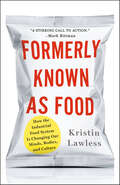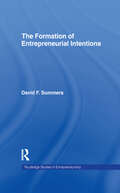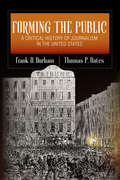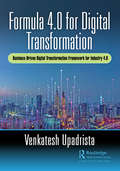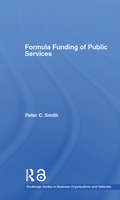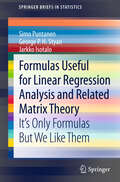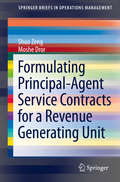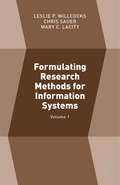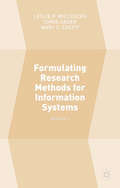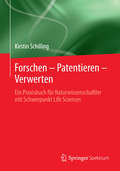- Table View
- List View
Formen der Entscheidungsfindung in Matrixstrukturen: Eine empirische Untersuchung von Ausprägungen, Einflussfaktoren und Koordinationsinstrumenten in multinationalen Unternehmen
by Christian KollsDer Einsatz der Matrixstruktur wird in der letzten Zeit wieder verstärkt in der Unternehmenspraxis beobachtet. Dieser aufbauorganisatorische Ansatz wird dabei genutzt, um der steigenden Komplexität der Unternehmensumwelt, insbesondere in einem multinationalen Umfeld, zu begegnen. In Form einer empirisch-qualitativen Untersuchung untersucht Christian Kolls Faktoren, die Einfluss auf die Entscheidungsfindung innerhalb einer Matrixstruktur und somit auf eine erfolgreiche Implementierung und Anwendung nehmen. Nicht zuletzt durch die detaillierte und kritische Betrachtung der Wirkung einer Vielzahl von Koordinationsinstrumenten gelingt dabei ein bemerkenswerter Einblick in die potenziell erfolgreiche Nutzung einer Matrixstruktur in multinationalen Unternehmen.
Formen der: Ihr Zugang zu Geld und Chancengleichheit (essentials)
by Quirin Graf Adelmann v. A.Geld ist Tauschmittel, Zeitreserve der Zukunft und Motor eines Unternehmens. Unternehmensgründende und Unternehmen im Rahmen von Strukturwandel brauchen oft Geld, ohne entsprechende Sicherheiten für die benötigten Mittel bieten zu können. Zugang zu Geld und Finanzierungen auch ohne Eigenkapital zu erhalten, wird insbesondere bei steigenden Zinsen eine besondere Herausforderung. Neben klassischen Finanzierern wie Banken, gibt es inzwischen zahlreiche weitere Möglichkeiten, Unternehmungen zu finanzieren, ohne sich Geldgebern, Zins und Tilgung völlig auszuliefern. Eigene Finanzierungspotentiale zu identifizieren und zu nutzen, erfordert grundlegendes Verständnis für die Funktion und Aufbau von Finanzierungen sowie für die Motivation und die Sichtweisen von Geldgebern.In diesem Buch werden die Grundlagen zu Finanzierungen gegeben und die Angst vor dem Zauber einer Finanzierungsanfrage genommen. Der Autor erläutert anhand eigener unternehmerischer Beispiele, wie es gelingen kann, die beste Perspektive und Planung für das eigene Vorhaben zur Geldbeschaffung zu ermitteln und anzugehen.
Former Yugoslav Republic of Macedonia: Report on Observance of Standards and Codes--Fiscal Transparency Module
by International Monetary FundA report from the International Monetary Fund.
Formerly Known As Food: How the Industrial Food System Is Changing Our Minds, Bodies, and Culture
by Kristin LawlessSustainable Literature Commitee's2018 Green Prize Winner •One of Bustle's "17 Best Nonfiction Books Coming Out In June 2018" • One of The Revelator's "16 New Environmental Books for June" • One of Equinox's "5 Books High Performers Should Read in June" • One of Foodtank's "18 Books Making a Splash This Summer" •One of CivilEats' "22 Noteworthy Food and Farming Books for Summer Reading—and Beyond"From the voice of a new generation of food activists, a passionate and deeply-researched call for a new food movement.If you think buying organic from Whole Foods is protecting you, you're wrong. Our food—even what we're told is good for us—has changed for the worse in the past 100 years, its nutritional content deteriorating due to industrial farming and its composition altered due to the addition of thousands of chemicals from pesticides to packaging. We simply no longer know what we’re eating.In Formerly Known as Food, Kristin Lawless argues that, because of the degradation of our diet, our bodies are literally changing from the inside out. The billion-dollar food industry is reshaping our food preferences, altering our brains, changing the composition of our microbiota, and even affecting the expression of our genes. Lawless chronicles how this is happening and what it means for our bodies, health, and survival.An independent journalist and nutrition expert, Lawless is emerging as the voice of a new generation of food thinkers. After years of "eat this, not that" advice from doctors, journalists, and food faddists, she offers something completely different. Lawless presents a comprehensive explanation of the problem—going beyond nutrition to issues of food choice, class, race, and gender—and provides a sound and simple philosophy of eating, which she calls the "Whole Egg Theory."Destined to set the debate over food politics for the next decade, Formerly Known as Food speaks to a new generation looking for a different conversation about the food on our plates.Naomi Klein, author of No Is Not Enough and This Changes Everything:"In this revelatory survey of the dangers of the industrial food system, Lawless offers crucial tools for navigating it safely. The best ones have nothing to do with shopping advice: she asks us to think holistically about food, why it can't be separated from other struggles for justice, and what it means to demand transformative change." Mark Bittman, author of How to Cook Everything: "A stirring call to action. Lawless has done a thorough job of describing how so much of what we eat doesn't qualify as 'food'"Laurie David, Academy Award winning producer of An Inconvenient Truth and Fed Up: “You better read this book before you put another bite of food in your or your kids' mouths!” Mary Esther Malloy, MA, Mindful Birth NY: "Groundbreaking... will get you thinking differently about how you nourish yourself and your family."
Formidable Heritage: Manitoba's North and the Cost of Development
by Jim MochorukCanadians have an ambivalent feeling towards the North. Although climate and geography make our northern condition apparent, Canadians often forget about the north and its problems. Nevertheless, for the generation of historians that included Lower, Creighton, and Morton, the northern rivers, lakes, forests, and plains were often seen as primary characters in the drama of nation building. W.L. Morton even went so far as to write that the ìmain task of Canadian life has been to make something of that formidable heritageî of the northern Canadian shield. For many politicians and developers, "to make something" of the North came to mean thinking of the North as an empty hinterland waiting to be exploited, and today, hydroelectric projects, mining, milling, pulp and paper, and other industries have changed much of the North beyond recognition.One of the first parts of the North to be aggressively industrialized was northern Manitoba. When all of Manitoba was given in 1670 to a group of entrepreneurs, a precedent was set that was replicated throughout the provinceís history. After the province entered confederation in 1870, provincial politicians and business leaders began to look to the northern resources as a new key to the provinceís economic development. Particularly after 1912, they saw resource development in the North as a strategy to expand the provincial economy from its agricultural base. Jim Mochoruk shows how government and business worked together to transform what had been the exclusive fur-trading preserve of the Hudsonís Bay Company into an industrial hinterland. He follows the many twisting paths established by developers and politicians as they chased their goal of economic growth, and recounts the ultimate costs of development in economic, ecological, and political terms.
Forming Entrepreneurial Intentions: An Empirical Investigation of Personal and Situational Factors
by David F. SummersThis book examines the relationship between a person's intentions to start a business and specific personal and situational factors.
Forming the Public: A Critical History of Journalism in the United States (The History of Media and Communication)
by Thomas P. Oates Frank D. DurhamThroughout United States history, journalists and media workers have mobilized to promote and oppose various movements in public life. But a single meaning of the public remains elusive. Frank D. Durham and Thomas P. Oates provide an eye-opening analysis of the role played by journalism in the ongoing struggle to shape and transform ideas about the public. Using historical episodes and news reports, Durham and Oates offer examples of the influential words and images deployed by not only journalists but by media workers and activists. Their analysis moves from the patriot-inflamed emotions of the revolutionary period to the conventional and creative ways the American Indian Movement confronted the mainstream with their grievances. Weaving eyewitness history through US history, Forming the Public reveals what understanding the journalism landscape can teach us about the nature of journalism’s own interests in race, gender, and class while tracing the factors that shaped the contours of dominant American culture.
Forming the Team: The Crew and Its Charter
by Harvard Business Review PressOrganizing a team is the first step to accomplishing a common goal. At times, a team will self-organize; at other times, a manager will put together a team according to the critical competencies that each member brings. This chapter examines how effective teams are formed and the importance of a team charter.
Formlabs: Selling a New 3D Printer
by Frank V. Cespedes Amram Migdal Olivia HullHeadquartered in Somerville, Massachusetts, Formlabs manufactures 3D printers used to print everything from prototypes and models to jewelry, dental, and sculpture molds. As Formlabs prepares to ship its latest model, the Form 2, Head of Customer Development and Services Luke Winston wonders which strategy will double sales. Should he focus on direct sales or add more channel partners?
Forms of Organising in Industrial History (Routledge Focus on Industrial History)
by John F. Wilson, Steven Toms and Ian G. JonesThis shortform book presents key peer-reviewed research selected by expert series editors and contextualised by new analysis from each author on different forms of organising British industry. With contributions on the strengths and weaknesses of the holding company structure, government organisation of industry during war time, the effects of forms of organisation on innovation, and debates over the suitability of international comparisons, this volume provides an array of fascinating insights into industrial history. Of interest to business and economic historians, this shortform book also provides analysis and illustrative case-studies that will be valuable reading across the social sciences.
Formula 2 + 2: The Simple Solution for Successful Coaching (False Ser.)
by Douglas B Allen Dwight W AllenThe latest volume in Berrett-Koehler's Ken Blanchard Series Includes a foreword by Ken Blanchard, an introduction by Bill Cosby, and a mid-book message from lunar astronaut Buzz Aldrin Offers managers a simple system that will increase their effectiveness and improve employee morale and productivity Written in the accessible and compelling Blanchard storytelling style In today's fast-paced and rapidly changing business environment, frequent feedback and "course correction" is absolutely vital. But about the only time most managers offer employees feedback is during scheduled (and generally infrequent) performance appraisals, which tend to be stiff, formal, and-whether intentionally or not-adversarial, and therefore ineffective. Formula 2+2 offers a simple yet powerful approach to revolutionizing feedback conversations. It details the five secrets of effective feedback: making it timely, balanced between compliments and critiques, focused on high priority areas, supported with specific examples, and reinforced with appropriate follow-up. The book tracks the transformation of Pauline, a strong but traditional leader whose attempts at coaching and feedback are failing miserably. An old friend introduces her to Formula 2+2 and walks her through the five secrets of effectively implementing 2+2 feedback. Pauline discovers that providing feedback is not a necessary evil, but can become a welcome part of the manager's job. Formula 2+2 shows how to foster a culture of continuous feedback which increases the effectiveness of the manager, protects the spirit and dignity of employees, and provides a systematic approach to reinforcing and improving employee performance.
Formula 4.0 for Digital Transformation: A Business-Driven Digital Transformation Framework for Industry 4.0
by Venkatesh UpadristaA staggering 70% of digital transformations have failed as per McKinsey. The key reason why enterprises are failing in their digital transformation journey is because there is no standard framework existing in the industry that enterprises can use to transform themselves to digital. There are several books that speak about technologies such as Cloud, Artificial Intelligence and Data Analytics in silos, but none of these provides a holistic view on how enterprises can embark on a digital transformation journey and be successful using a combination of these technologies. FORMULA 4.0 is a methodology that provides clear guidance for enterprises aspiring to transform their traditional operating model to digital. Enterprises can use this framework as a readymade guide and plan their digital transformation journey. This book is intended for all chief executives, software managers, and leaders who intend to successfully lead this digital transformation journey. An enterprise can achieve success in digital transformation only of it can create an IT Platform that will enable them to adopt any new technology seamlessly into existing IT estate; deliver new products and services to the market in shorter durations; make business decisions with IT as an enabler and utilize automation in all its major business and IT processes. Achieving these goals is what defines a digital enterprise -- Formula 4.0 is a methodology for enterprises to achieve these goals and become digital. Essentially, there is no existing framework in the market that provides a step-by-step guide to enterprises on how to embark on their successful digital transformation journey. This book enables such transformations. Overall, the Formula 4.0 is an enterprise digital transformation framework that enables organizations to become truly digital.
Formula Funding of Public Services (Routledge Studies in Business Organizations and Networks)
by Peter C. SmithThe use of formulae has become widespread in recent years across most developed countries. In the UK, a conservative estimate is that annually £150 billion of public service expenditure is distributed using formulae, in services such as health care, local government, social security and higher education. This book offers a comprehensive introduction to the theory and practice underlying the use of such formulae as a basis for funding public services. The philosophy, design and economic consequences of funding formulae have become key policy issues worldwide. However, till now, there has been no text which brings together the economic, statistical and political issues underlying formula funding. This key book fills that gap. Written by a leading international expert on the design of funding formulae, this important book includes empirical evidence from a range of countries and will be a valuable resource for all those involved in this field.
Formula One 2024
by Bruce JonesThe world's bestselling Grand Prix handbook is back revised and fully updated for the new season.This is the definitive guide to Formula 1 in 2024. A complete examination of all the teams racing this season, every driver and all the tracks featured in the packed Grand Prix calendar.Also including a full review of the 2023 season and a breakdown of the revised rules and regulations for 2024, this indispensable guidebook features last season's drivers' and constructors' world championship results - as well as a fill-in chart for 2024, so each book becomes your own personalised guide to the year's action.Written by bestselling F1 author Bruce Jones and containing dozens of breathtaking photographs and detailed circuit illustrations plus a statistics section highlighting the major records in F1 history, this is the only guide you'll need for the racing action ahead.
Formula One 2024
by Bruce JonesThe world's bestselling Grand Prix handbook is back revised and fully updated for the new season.This is the definitive guide to Formula 1 in 2024. A complete examination of all the teams racing this season, every driver and all the tracks featured in the packed Grand Prix calendar.Also including a full review of the 2023 season and a breakdown of the revised rules and regulations for 2024, this indispensable guidebook features last season's drivers' and constructors' world championship results - as well as a fill-in chart for 2024, so each book becomes your own personalised guide to the year's action.Written by bestselling F1 author Bruce Jones and containing dozens of breathtaking photographs and detailed circuit illustrations plus a statistics section highlighting the major records in F1 history, this is the only guide you'll need for the racing action ahead.
Formula One Motor Racing
by David Lane Tarun Khanna Kartick VarmaDocuments the entrepreneurial efforts of a single individual to bring together car and engine manufacturers, local circuit owners and promoters, advertisers, drivers, and fans in the creation of one of the biggest markets for world sports.
Formulas Useful for Linear Regression Analysis and Related Matrix Theory: It's Only Formulas But We Like Them
by Simo Puntanen George P. Styan Jarkko IsotaloThis is an unusual book because it contains a great deal of formulas. Hence it is a blend of monograph, textbook, and handbook.It is intended for students and researchers who need quick access to useful formulas appearing in the linear regression model and related matrix theory. This is not a regular textbook - this is supporting material for courses given in linear statistical models. Such courses are extremely common at universities with quantitative statistical analysis programs.
Formulating Principal-Agent Service Contracts for a Revenue Generating Unit
by Shuo Zeng Moshe DrorThis book examines contractual options for a performance based contract between an owner of a revenue generating unit and a repair agent for such unit. The framework of the analysis is that of economists' principal-agent problem. The contractual options of a principal and an agent are modeled as a Markov process with an undetermined time horizon. For a risk neutral principal, the authors identify the conditions under which a principal contracts with a risk-neutral, risk-averse, or risk-seeking agent and derive the principal's optimal offer together with the agent's optimal service capacity response. In essence, the book provides an extensive formulating analysis of principal-agent contracts given any exogenous parameter values. Ultimately a small number of formulas cover a large spectrum of principal-agent conditions.
Formulating Research Methods for Information Systems: Volume 1
by Leslie P. Willcocks Mary C. Lacity Chris SauerThis edited two-volume collection presents the most interesting and compelling articles pertaining to the formulation of research methods used to study information systems from the 30-year publication history of the Journal of Information Technology .
Formulating Research Methods for Information Systems: Volume 2
by Leslie P. Willcocks Mary C. Lacity Chris SauerThis edited two-volume collection presents the most interesting and compelling articles pertaining to the formulation of research methods used to study information systems from the 30 year publication history of the Journal of Information Technology (JIT).
Formulating a Strategic Blueprint for Action: How State Street Reinvented Its Business and How the Axe Brand Redefined an Entire Category
by Erich JoachimsthalerCompanies that do not explicitly define, structure, analyze, and prioritize their opportunity spaces often chase romantic dreams about big ideas and breakthrough products or services, but fail to realize those dreams. This chapter describes how State Street and Axe brand created strategies that guided the activation of new growth platforms from the highest strategic level all the way to activation in customers' everyday lives.
Formulation Simplified: Finding the Sweet Spot through Design and Analysis of Experiments with Mixtures
by Mark J. Anderson Patrick J. Whitcomb Martin A. BezenerMany chemists – especially those most brilliant in their field – fail to appreciate the power of planned experimentation. They dislike the mathematical aspects of statistical analysis. In addition, these otherwise very capable chemists also dismissed predictive models based only on empirical data. Ironically, in the hands of subject matter experts like these elite chemists, the statistical methods of mixture design and analysis provide the means for rapidly converging on optimal compositions. What differentiates Formulation Simplified from the standard statistical texts on mixture design is that the authors make the topic relatively easy and fun to read. They provide a whole new collection of insighful original studies that illustrate the essentials of mixture design and analysis. Solid industrial examples are offered as problems at the end of many chapters for those who are serious about trying new tools on their own. Statistical software to do the computations can be freely accessed via a web site developed in support of this book.
Foro Energy (A)
by William A. Sahlman Joseph B. Lassiter James McquadeForo Energy developed proprietary and patent-pending fiber-laser technologies that could disrupt existing processes and services for the exploration and production of oil and natural gas. These breakthrough laser technologies were protected by a strong intellectual property (IP) portfolio, which provided Foro with the flexibility to pursue a number of different business models. The market potential for oilfield applications was large, as global spending in the O&G E&P industry was expected to approach $600 billion in 2012.
Forschen – Patentieren – Lizenzieren: Aus der Wissenschaft über Patentschutz bis zur Spin-off-Gründung
by Kirstin SchillingDieser Ratgeber erklärt, wie Forschungsergebnisse aus Universitäten und Hochschulen patentiert und lizenziert oder verkauft werden können. Wichtige Aspekte des Erfindungs-, Patent- und Lizenzrechts werden anhand von Beispielen erläutert.Im ersten Teil werden Fragen beantwortet, was eine patentierbare Erfindung ist und welche Erfindervergütung Forschenden an Hochschulen zusteht. Ausführlich behandelt wird u.a. das Thema, wie Forschungsergebnisse publiziert und trotzdem patentiert werden können.Im zweiten Teil, speziell zum Patentieren, wird gezeigt, wie eine Patentanmeldung aufgebaut ist, wie Patentprüfverfahren ablaufen und was sie kosten. Mit vielen Praxistipps wird erklärt, wie man eine Patentrecherche durchführt und ermittelt, ob ein Patent noch aktiv ist. Zudem wird erläutert, welche Besonderheiten beim Schutz von Erfindungen für medizinische Anwendungen zu beachten sind.Im dritten Teil werden verschiedene vertragliche Lösungen zur Anbahnung sowie zum Abschluss von Lizenz- und anderen Verwertungsvereinbarungen vorgestellt. Häufige Probleme bei der Finanzierung der Weiterentwicklung von Projekten werden adressiert und Lösungen aufgezeigt. Der Schlussteil ist speziell dem Thema der Gründung von akademischen Spin-off-Unternehmen gewidmet. Die aktualisierte und erweiterte 2. Auflage enthält neue Beiträge zu den Themen Software-Schutz und -Lizenzierung und zu den Möglichkeiten, patentgeschützte Technologien weiterzuentwickeln. Neue Beispiele sowie verlinkte Interviews mit Experten illustrieren Best-practice-Fälle.Das Buch eignet sich sowohl als Übersicht für Einsteiger als auch zum gelegentlichen Nachschlagen für gestandene Erfinder. Es richtet sich grundsätzlich an alle Forschenden in den Naturwissenschaften und der Medizin sowie Mitarbeitende des Technologietransfers an Universitäten, Universitätskliniken und Hochschulen. Videos per App: einfach die SN More Media App kostenfrei herunterladen, ein Bild oder einen Link mit dem Play-Button scannen und sofort das Video auf Smartphone oder Tablet ausspielen.
Forschen – Patentieren – Verwerten: Ein Praxisbuch für Naturwissenschaftler mit Schwerpunkt Life Sciences
by Kirstin SchillingDieses Praxisbuch erklärt, wie Forschungsergebnisse von Wissenschaftlern aus Universitäten und Hochschulen patentiert und kommerziell verwertet werden können. Wichtige Aspekte des Erfinder- und Patentrechts werden anhand von Beispielen erläutert und es finden sich praktische Tipps, etwa zur Durchführung von Patentrecherchen oder zur Gründung von Spin-off-Unternehmen.Aus dem Inhalt:Was ist ein Patent und wie sieht es aus?Neuheits- und PatentrechercheWelche Forschungsergebnisse können patentiert werden?Patentieren und PublizierenAblauf und Kosten von PatentverfahrenErfinderrechte, Erfinderpflichten & ErfindervergütungIP-Rechte in ForschungskooperationenGeheimhaltungsvereinbarung & MaterialaustauschvereinbarungLizensieren oder Verkaufen von PatentenDas Buch eignet sowohl als Übersicht für Einsteiger, als auch zum gelegentlichen Nachschlagen für gestandene Erfinder. Es richtet sich grundsätzlich an alle Naturwissenschaftler und Mediziner an Universitäten, Universitätskliniken und Hochschulen. Viele Beispiele entstammen dem Life-Science-Bereich, so dass besonders Biologen, Chemiker, Pharmazeuten und Mediziner angesprochen werden.



